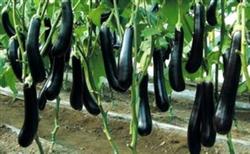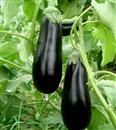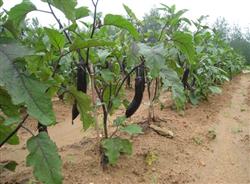Cultivation techniques of eggplant in winter and spring in greenhouse

1. Early-maturing or mid-maturing varieties are selected for sowing seedlings, and the seedlings can be sowed from late November to early December with a seedling age of more than 90 days. If the seedlings are raised in an electric hotbed or sowed in a winter greenhouse, the seedling age can be shortened to 70-80 days, that is, the sowing date can be postponed to the middle or late December. The morphological index of the appropriate age seedlings was that the eggplant flower began to bud. For specific operation techniques, see Chapter 5. two。 The suitable temperature index for planting eggplant is that the ground temperature of 10 cm in the greenhouse is stable between 12 and 15 ℃. In all parts of Shandong Province, the arch greenhouse is covered with single-layer plastic film, and the planting period is late March; the arch greenhouse is covered by multi-layer protection or spring greenhouse with single slope, and the planting period can be advanced from late February to early March. The plastic film should be fastened to the shed as early as possible before planting in order to increase the temperature in the shed. In the greenhouse with previous crops, stubble should be removed early, and the old greenhouse should be fumigated with chemicals in the greenhouse. After stubble in the buckle shed, deep ploughing should be carried out, combined with the application of basic fertilizer, and ridging cultivation should be adopted. The methods and specifications of soil preparation, application of base fertilizer and ridging are the same as those of overwintering cultivation. 3. Management after planting (1) low ground temperature after planting is the main limiting factor affecting the growth and development of eggplant. The main thing is to increase the greenhouse temperature within 10-15 days after planting. The greenhouse temperature can reach more than 30 ℃ during the day, and the greenhouse temperature can be used to increase the ground temperature. At this time, the lunchtime should be breathed against the wind for a short time, but not to let the door wind, let alone the bottom wind, and to strengthen loosening the soil, improve the ground temperature, and promote the root. Single slope greenhouse and multi-layer covering greenhouse should pay attention to uncover the opaque cover early and late, not only close heat preservation, but also full daylighting. (2) after fruit setting in the early stage, in order to strive for early maturity and high yield, attention should be paid to flower and fruit protection, branch and leaf growth, and high yield skeleton. At this stage, attention should be paid to greenhouse temperature regulation and ventilation management should be strengthened. During the day, the greenhouse temperature of 28 to 30 ℃ should be maintained for more than 5 hours, ventilation began when the greenhouse temperature reached 32 ℃ in the morning, and the ventilation outlet should be closed when the temperature dropped below 25 ℃ in the afternoon. We should also pay attention to adjust the relationship between plant growth and fruit, remove all the lateral branches below the first branch, such as double-stem pruning, but also get rid of the excess lateral buds in time. And in the door eggplant fruit after proper cultivation, height of about 10 cm, promote hair root, prevent lodging. The early water management of eggplant should be mainly controlled, less irrigation, more loose soil, especially during the flowering period of eggplant, the soil moisture should not be too high, otherwise it is easy to drop flowers and fruits. Fertilize and irrigate when the door eggplant grows to the size of a walnut. 20 kg of urea or 1000 kg of feces and urine per mu. In order to prevent the soil temperature from falling in the early stage, the methods of sunny morning irrigation and ditch irrigation can be adopted during irrigation. In order to protect flowers and fruits, 20 mg / L (20ppm) of 2meme 4mer D can be used to dip flowers. (3) after the management of the full fruit period has entered the peak fruit period, the greenhouse has entered a high temperature period. in order to prevent the harm of high temperature, the ventilation rate should be increased. All the film under the shoulder of the greenhouse can be rolled up. Close the skylight when the night temperature is not less than 17 ℃ and ventilate day and night. In order to enhance photosynthesis and good coloring of eggplant, the film at the top of the greenhouse can be removed after June. The full fruit period requires plenty of fertilizer and water to ensure the development of fruit. Water can be watered every 5-6 days and topdressing every two water. It is best to use chemical fertilizer and organic fertilizer alternately. Entering the full fruit stage, the old leaves and yellow leaves at the base can be knocked off, the ventilation and light transmission conditions can be improved, nutrients can be concentrated to attack the fruit, and the fruit growth can be promoted. 4. Pay attention to the prevention and control of diseases and insect pests in the greenhouse in the middle and later stages of the growth of eggplant in winter and spring, due to the rise of air temperature, high temperature and humidity in the greenhouse, diseases and insect pests occur from time to time. The main diseases are cotton blight, brown stripe, etc., and insect pests are mainly aphids, tea yellow mites, whitefly, etc., which should be controlled in time. First of all, the prevention and control of diseases is to do a good job in the management of temperature and humidity in the shed, especially pay attention to the control of temperature. the occurrence of these diseases is not directly related to excessive humidity in the shed. The main way to control the humidity in the greenhouse is to do a good job of ventilation and moisture drainage of the greenhouse, especially after watering.
- Prev

Early ripening cultivation techniques of eggplant in greenhouse
Seed selection and seedling cultivation: eggplant varieties with early maturity, high yield, disease resistance and high quality should be selected for eggplant cultivation in early spring. Such as Zhoukou crooked rough, Xinxiang rough green eggplant. These two varieties generally have 7 leaves and are suitable for close planting. The seedlings are raised by hot wire in the greenhouse. The seedlings are 90-100 days old and have 7-8 leaves. They are best planted in big buds. Miao.
- Next

Technology of picking and scion with multiple buds of eggplant in protected field
Eggplant grafting cultivation has become the most important way of disease resistance and yield increase in eggplant production in protected areas. When eggplant is grafted and raised. The one-seedling-one-bud scion picking technique is generally adopted, which has the advantages of high seed cost and high production cost. To this end, according to the principle of top dominance of plant growth, combined with eggplant seedling side.
Related
- Where is it suitable to grow horseradish in China? it is expected to see the middle altitude horseradish in Alishan.
- How to prevent tomato virus disease reasonably? (Control methods included)
- Many people like to plant towel gourd on the balcony. What are the main points of this method and management?
- What crops can chili peppers be mixed with?
- Fertilization techniques and matters needing attention in Tomato
- What are the grafting techniques for peach seedlings in spring?
- Harm and control methods of root swelling disease of Chinese cabbage
- What are the pests of sweet potatoes? How to prevent and cure it?
- Symptoms, causes and Control methods of navel Rot in Tomato
- The cause of "Cucumber rotten bibcock" in Farmers' planting Cucumber and its Control Plan

